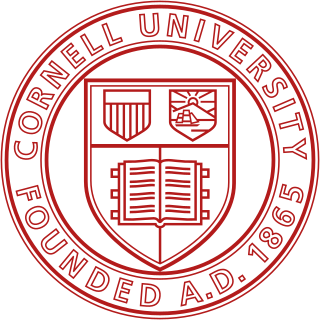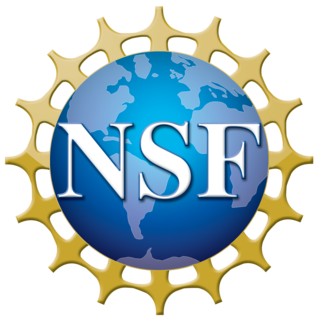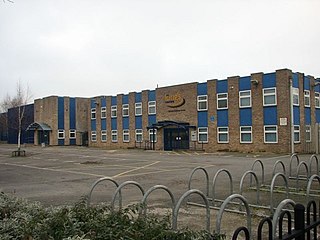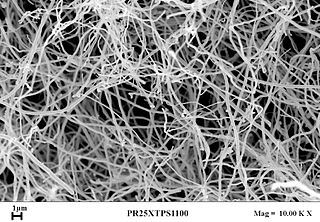The Cornell NanoScale Science and Technology Facility (CNF) is a scientific user facility and cleanroom which is located at Cornell University in Ithaca, New York. The CNF is one of the sixteen members of the National Nanotechnology Coordinated Infrastructure (NNCI).

A cleanroom or clean room is a laboratory facility ordinarily utilized as a part of specialized industrial production or scientific research, including the manufacture of pharmaceutical items and microprocessors. Cleanrooms are designed to maintain extremely low levels of particulates, such as dust, airborne organisms, or vaporized particles. Cleanrooms typically have a cleanliness level quantified by the number of particles per cubic meter at a predetermined molecule measure. The ambient outdoor air in a typical urban area contains 35,000,000 particles for each cubic meter in the size range 0.5 μm and bigger in measurement, equivalent to an ISO 9 cleanroom, while by comparison an ISO 1 cleanroom permits no particles in that size range and just 12 particles for each cubic meter of 0.3 μm and smaller.

Cornell University is a private and statutory Ivy League research university in Ithaca, New York. Founded in 1865 by Ezra Cornell and Andrew Dickson White, the university was intended to teach and make contributions in all fields of knowledge—from the classics to the sciences, and from the theoretical to the applied. These ideals, unconventional for the time, are captured in Cornell's founding principle, a popular 1868 Ezra Cornell quotation: "I would found an institution where any person can find instruction in any study."

Ithaca is a city in the Finger Lakes region of New York. It is the seat of Tompkins County, as well as the largest community in the Ithaca–Tompkins County metropolitan area. This area contains the municipalities of the Town of Ithaca, the village of Cayuga Heights, and other towns and villages in Tompkins County. The city of Ithaca is located on the southern shore of Cayuga Lake, in Central New York, about 45 miles (72 km) south-west of Syracuse. It is named after the Greek island of Ithaca. Additionally, Ithaca is located 247 miles (398 km) southeast of Toronto, and 223 miles (359 km) northwest of New York City.
The CNF was started as part of a National Science Foundation initiative in 1977, and has subsequently been partially supported by several other NSF programs. [1] It currently receives about $20 million each year in federal funding. [2] In 2004 the CNF moved into its current facility, Duffield Hall, supported by $100 million in support from Cornell. It now includes 15,000 square feet of Level 1000 cleanroom as well as several times more non-cleanroom laboratory space. [3] In 2009 the NNIN received $10 million as part of the American Recovery and Reinvestment Act. [4]

The National Science Foundation (NSF) is a United States government agency that supports fundamental research and education in all the non-medical fields of science and engineering. Its medical counterpart is the National Institutes of Health. With an annual budget of about US$7.8 billion, the NSF funds approximately 24% of all federally supported basic research conducted by the United States' colleges and universities. In some fields, such as mathematics, computer science, economics, and the social sciences, the NSF is the major source of federal backing.
The CNF is a general user facility, and while many users are from Cornell or other nearby universities, it also draws users from a wide range of universities and companies around the world. [5] Roughly 700 scientists use the facility every year, half of whom are associated with Cornell. [6]
The CNF is used for research in a wide range of fields such as MEMS, microfluidics, nanomagnetics and bioelectronics. It includes fabrication tools for processes including electron-beam lithography, photolithography, chemical vapor deposition, electron-beam deposition and reactive ion etching. It also contains characterization equipment including scanning electron microscopes, ellipsometers and probe stations for electrical measurement.
Microfluidics deals with the behaviour, precise control and manipulation of fluids that are geometrically constrained to a small, typically sub-millimeter, scale at which capillary penetration governs mass transport. It is a multidisciplinary field at the intersection of engineering, physics, chemistry, biochemistry, nanotechnology, and biotechnology, with practical applications in the design of systems in which low volumes of fluids are processed to achieve multiplexing, automation, and high-throughput screening. Microfluidics emerged in the beginning of the 1980s and is used in the development of inkjet printheads, DNA chips, lab-on-a-chip technology, micro-propulsion, and micro-thermal technologies.
A nanomagnet is a submicrometric system that presents spontaneous magnetic order (magnetization) at zero applied magnetic field (remanence).
Bioelectronics is a field of research in the convergence of biology and electronics.











